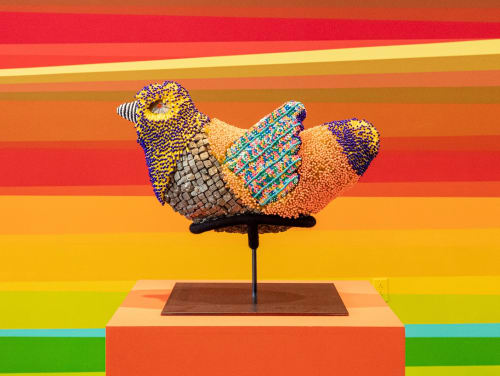
“The land is always speaking and has memory,” Jeffrey Gibson says, as he describes his work in an audio guide for his solo exhibition The Body Electric at SITE Santa Fe last year. “I am frustrated to see how many people continue to abuse the land, take from it, never thank the land, or care for it. Or allow it to rest. So I ask the question: Are you listening? Are we listening?”
Rooted in the myriad ways narratives are constructed and shared, Gibson’s practice incorporates a vivid palette and a multitude of materials that range from glass beads and artificial sinew to fiber fill and sea glass. Vibrant color and graphic forms outline geometric patchworks that include words of affirmation, mottos, and acknowledgments. Quilt-like compositions mingle intricate patterns with symbols and references to myth, Indigenous knowledge, literature, and queer identities.
Throughout his childhood, Gibson moved often and spent periods in Germany, Korea, and the United States, travels that prompted him to suffuse his practice with a multicultural perspective and percolate on popular culture, identity politics, and personal experience. A member of the Chocktaw and Cherokee nations, he fuses the visual languages of Modernism and Indigenous American traditions, drawing inspiration from music, storytelling, and performance. He often incorporates song lyrics into his works or presents provocative snippets of text, like in the bead-framed painting “WHAT WE WANT IS FREE” or one of his Punching Bags titled “I AM A RAINBOW.”
In a group of figurative sculptures, some of which are life-size, Gibson blurs the boundaries between regional traditions and historical eras. He was inspired by a series of dolls from the Plains tribe region that depicted a spectrum of genders, which he encountered when he worked as a Native American Graves Protection and Repatriation Act assistant at Chicago’s Field Museum—NAGPRA is a congressional provision established in 1990 for federal agencies and museums to repatriate or transfer items from their collections to lineal descendants and tribes. Gibson uses these works to explore the way dolls represent the aesthetics of peoples around the world and serve as a medium of social instruction. He carefully avoids assigning the sculptures a gender, which he describes as a proposing a “future hybridity” in which identity and cultural associations are fluid.

